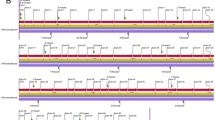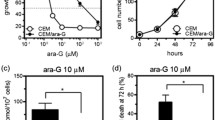Abstract
Purpose: Cell cycle-related events in CCRF-CEM lymphocytic leukemia cells were examined subsequent to inhibition of thymidylate synthase (TS) or GAR formyltransferase (GARFT) and prior to cell death or stasis. Methods: Cell populations were treated with the GARFT inhibitors 6R-5,10-dideazatetrahydrofolate (lometrexol) or LY309887, the TS inhibitor ZD1694, or the multitargeted antifolate LY231514. DNA content, nucleoside precursor incorporation and proliferating cell nuclear antigen (PCNA) expression as functions of drug treatment were assessed by multiparameter flow cytometry. Cellular respiration was measured by MTT analysis and apoptosis was detected by extraction of DNA fragments. Results: Cell populations treated for up to 96 h with lometrexol or LY309887 did not replicate and maintained a cell cycle distribution with distinct G1, S and G2/M regions. The number of S phase cells in treated populations was slightly elevated relative to control as measured by DNA content and PCNA. However, these cells were unable to incorporate 5-bromodeoxyuridine (BrdU). Throughout treatment, cells incubated with GARFT inhibitors maintained intact membranes and respired at a level comparable to untreated cells. In contrast, ZD1694 as well as LY231514, induced synchronization of the treatment population at the G1/S interface within 12 h of drug addition. This was followed by synchronous entry of the population into S phase. After 24 h of treatment, more than 90% of the cells were capable of incorporating BrdU and stained positive for PCNA. DNA fragmentation occurred in cells treated with ZD1694 or LY231514 but not in those treated with GARFT inhibitors. In addition, the viable cells remaining after 24–48 h of treatment with ZD1694 or LY231514 were respiring at twice the level of untreated cells. Conclusion: These results demonstrate that the distinct endpoints of GARFT and TS inhibition are preceded by distinct cell cycle and metabolic alterations.
Similar content being viewed by others
Author information
Authors and Affiliations
Additional information
Received: 1 April 1996 / Accepted: 5 September 1996
Rights and permissions
About this article
Cite this article
Tonkinson, J., Marder, P., Andis, S. et al. Cell cycle effects of antifolate antimetabolites: implications for cytotoxicity and cytostasis. Cancer Chemother Pharmacol 39, 521–531 (1997). https://doi.org/10.1007/s002800050608
Issue Date:
DOI: https://doi.org/10.1007/s002800050608




